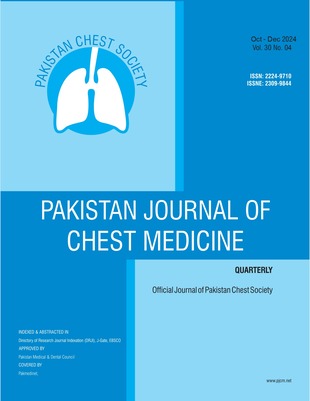Association of Baseline Hematological Parameters with Thromboembolic Events in Hospitalized COVID-19 Patients
Keywords:
COVID-19, Thromboembolic Events, D-Dimer, MPVAbstract
Background: COVID-19 carries an increased risk of blood clot complications because of its effects on the body's inflammation and clotting processes. Identifying patients who are at risk as early as possible is crucial for healthcare providers. Regular blood tests can provide useful information to predict these risks. Objective: To determine the frequency of in-hospital thromboembolic events among COVID-19 patients and assess the influence of blood parameters, measured at the time of admission, on the occurrence of these events. Methodology: This retrospective study included 364 hospitalized COVID-19 patients. Demographic, clinical, and laboratory data at admission were collected from medical records. Thromboembolic events were documented and confirmed through clinical and imaging findings. Logistic regression analysis was used to identify independent predictors. Results: Thromboembolic events occurred in 6.6% of hospitalized COVID-19 patients, with myocardial infarction being the most common. Patients with such events had significantly lower hemoglobin, higher MPV, and elevated D-dimer levels. Age, low hemoglobin, and high MPV were identified as independent predictors. No significant differences were observed in C-reactive protein, LDH, or total WBC count. Conclusion: Age, low hemoglobin, and high MPV are independent predictors of thromboembolic events in hospitalized COVID-19 patients. These common blood parameters may help identify risk early. Including them in clinical assessments can improve prevention measures. More prospective studies are necessary to confirm these findings.References
Chen G, Wu D, Guo W, Cao Y, Huang D, Wang H, et al. The use of anti-inflammatory drugs in the treatment of people with severe coronavirus disease 2019 (COVID-19): The Perspectives of clinical immunologists from China. Clin Immunol. 2020;215:108393. DOI: 10.1016/j.clim.2020.108393.
Zhou F, Yu T, Du R, Fan G, Liu Y, Liu Z, et al. Clinical course and risk factors for mortality of adult inpatients with COVID-19 in Wuhan, China: a retrospective cohort study. Lancet. 2020;395(10229):1054–1062. DOI: 10.1016/S0140-6736(20)30566-3.
Słomka A, Kowalewski M, Żekanowska E. Hemostasis in coronavirus disease 2019—lesson from viscoelastic methods: a systematic review.. Thromb Haemost. 2021;121(9):1181–1192. DOI: 10.1055/a-1346-3178.
Alnima T, Mulder MMG, van Bussel BCT, Ten Cate H. COVID-19 coagulopathy: from pathogenesis to treatment. Acta Haematol. 2022;145(3):282–296. DOI: 10.1159/000522498.
Bikdeli B, Madhavan MV, Jimenez D, Chuich T, Dreyfus I, Driggin E, et al. COVID-19 and thrombotic or thromboembolic disease: implications for prevention, antithrombotic therapy, and follow-up: JACC state-of-the-art review. J Am Coll Cardiol. 2020;75(23):2950–2973. DOI: 10.1016/j.jacc.2020.04.031.
Klok FA, Kruip MJHA, van der Meer NJM, Arbous MS, Gommers DAMPJ, Kant KM, et al. Incidence of thrombotic complications in critically ill ICU patients with COVID-19. Thromb Res. 2020;191:145–147. DOI: 10.1016/j.thromres.2020.04.013
Gupta A, Madhavan MV, Sehgal K, Nair N, Mahajan S, Sehrawat TS, et al. Extrapulmonary manifestations of COVID-19. Nat Med. 2020;26(7):1017–1032. DOI: 10.1038/s41591-020-0968-3.
Seyfi S, Azadmehr A, Ezoji K, Nabipour M, Babazadeh A, Saleki K, et al. Mortality in ICU COVIDâ€19 Patients Is Associated with Neutrophilâ€toâ€Lymphocyte Ratio (NLR): Utility of NLR as a Promising Immunohematological Marker. Interdiscip Perspect Infect Dis. 2023;2023:9048749. DOI: 10.1155/2023/9048749.
Alizad G, Ayatollahi AA, Shariati Samani A, Samadizadeh S, Aghcheli B, Rajabi A, et al. Hematological and Biochemical Laboratory Parameters in COVIDâ€19 Patients: A Retrospective Modeling Study of Severity and Mortality Predictors. Biomed Res Int. 2023;2023:7753631. DOI: 10.1155/2023/7753631.
Zein AFMZ, Sulistiyana CS, Raffaelo WM, Pranata R. The association between mean platelet volume and poor outcome in patients with COVID-19: Systematic review, meta-analysis, and meta-regression. J Intensive Care Soc. 2023;24(3):299–308. DOI: 10.1177/17511437221121234.
Duan R, Ni Q, Li Y, Zhu M, Li W, Wang P, et al. Lymphocytes, mean platelet volume, and albumin in critically ill COVID-19 patients with venous thromboembolism. Clin Appl Thromb Hemost. 2023;29:10760296231177676. DOI: 10.1177/10760296231177676.
Hultcrantz M, Modlitba A, Vasan SK, Sjölander A, Rostgaard K, Landgren O, et al. Thromb Res. 2020;186:86–92. DOI: 10.1016/j.thromres.2019.12.011.
Sadeghi S, Nasri P, Nasirian M, Mirenayat MS, Toghyani A, Khaksar M, et al. J Renal Inj Prev. 2022;11(2):31957. DOI: 10.34172/jrip.2022.31957.
Degrave R, Murris J, Charles-Nelson A, Hermine O, Porcher R, Ravaud P, et al. Risk factors for thromboembolic events in patients hospitalized for COVID-19 pneumonia in a general ward and requiring treatment with oxygen. Postgrad Med J. 2023;100(1180):120–126. DOI: 10.1136/postmj.qgad104.
Lalor N, Raffaeli A, Torres N, Silveyra D, Aphalo V, Scapellato JL. Major arterial and venous thromboembolic complications in patients with COVID-19. Medicina (B Aires). 2022;82(1):21–27. DOI: 10.1007/s00408-022-00514-1.
Jurin I, Lucijanić M, PiskaÄ Å½ivković N, Lalić K, Zrilić Vrkljan A, Malnar JaneÅ¡ L, et al. Incidence and risk factors for venous and arterial thromboses in hospitalized patients with COVID-19: Data on 4014 patients from a tertiary center registry. Croat Med J. 2022;63(1):16–26. DOI: 10.3325/cmj.2022.63.16.
Al Nafea HM, Al-Qahtani MT, Al Gahtani FH, Tabassum H. Blood coagulation, risk factors, and associated complications in COVID-19 patients in Saudi Arabia: A retrospective cohort study. Medicine (Baltimore). 2023;102(43):e35621. DOI: 10.1097/MD.0000000000035621.
Radkhah H, Mansouri ES, Anaraki SR, Mesgarha MG, Sheikhy A, Khadembashiri MM, et al. Predictive value of hematological indices on incidence and severity of pulmonary embolism in COVID-19 patients. Immun Inflamm Dis. 2023;11(9):e1012. DOI: 10.1002/iid3.1012.
Zuin M, Rigatelli G, Roncon L, Zuliani G, Ronco C. Pulmonary embolism in COVID-19 and mortality: a systematic review and meta-analysis. Crit Care. 2020;24:395. DOI: 10.1186/s13054-020-03140-5.
Martinot M, Eyriey M, Gravier S, Bonijoly T, Kayser D, Ion C, et al. Predictors of mortality, ICU hospitalization, and extrapulmonary complications in COVID-19 patients. Infect Dis Now. 2021;51(6):518–525. DOI: 10.1016/j.idnow.2021.07.002.
Gozukucuk R, Kılıc HH, Uyanik BS, Cakiroglu B. The importance of hematological parameters in the prognosis of patients with severe COVID-19: A single-center retrospective study. Niger J Clin Pract. 2023;26(9):1297–1302. DOI: 10.4103/njcp.njcp_22_23.
Downloads
Published
How to Cite
Issue
Section
License
Copyright (c) 2024 Pakistan Journal of Chest Medicine

This work is licensed under a Creative Commons Attribution-NonCommercial 4.0 International License.








